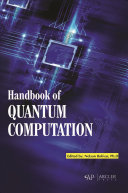Product desciption
Handbook Of Quantum Computation Nelson Bolivar by Nelson Bolivar 9781773611013, 9781773616926, 1773611011, 1773616927 instant download after payment.
Throughout history mankind has used different materials and multiple mechanisms in the design, construction and operation of machines that speed and automate the processing of information and calculations. In the past, the first models were manual, these date back when the Egyptians invented a device that consisted of a number of areas crossed by rods; This artifact was changed and perfected by the Chinese; and later in the 13th century D. C. It is when the classic form that we know; the abacus, which is composed of 10 lines with 7 fields each, a line cut all lines into two parts a bigger that the other, placing 2 spheres at the top and five in the bottom.Much later, mechanical and electrical models were developed, so that, Blaise Pascal, in 1649, manufactured the PASCALINE, a machine that made operations of 8 digits. In 1820, Charles Babbage built two completely mechanical equipment, axles, gears and pulleys used to perform calculations. Konraz Suze, in 1942, built the first digital computer programmable. Between 1937 and 1942 Atanasoff and Berry, built a prototype Composite tubes, capacitors and a drum from rotating the elements of memory management. In 1941, Turing built the COLLOSUS, a computer using thousands of valves, 2400 pumps of glass, and a scanner with the ability to read 5000 characters by paper tape. In 1944, IBM built the MARK I, with an average of 15 meters long and 2.40 meters high and weighed five tons. Then, the digital era started, with electronic models based initially in vacuum tubes and then transistors. The EDVAC was the first digital electronic computer, its memory consisted of lines of mercury within a glass vacuum tube, where you could store ones and zeros. The invention of the transistor influenced dramatically the evolution of computers. It was conceived in 1948, by three scientists at Bell Labs. This contains a semiconductor material that functions as a switch. In en 1958 1958 Kilby and Noycea, of the Texas Instrument, invented integrat


